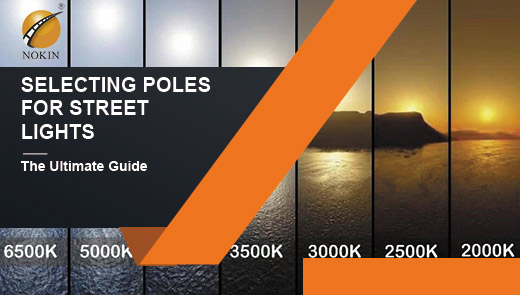Qualities A Good LED Solar Street Light Should Have
In today's society, with the advancement of science and technology and the development of cities, energy saving has become one of the top agendas of city management. LED Solar street lights are becoming more and more important in the field of lighting in cities and villages due to its energy saving, environmental protection and many other advantages. So, what kind of LED solar street light is considered high quality? Next, we will analyze from a number of key aspects.
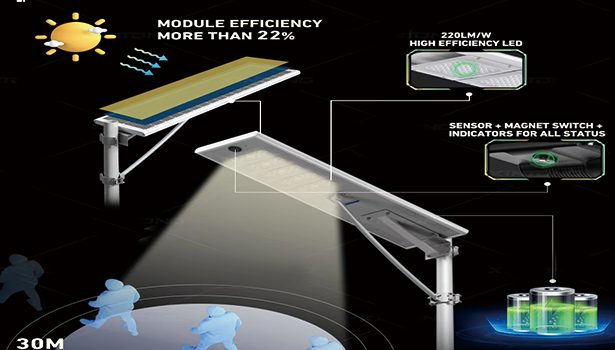
Key components of led solar street lights and their quality
Photovoltaic (PV) panels
Decide the key role of brightness
To achieve the set brightness of the light source, it needs sufficient power to drive. For example, a 1W light source requires about 300mAH of power for 1 hour. The role of the photovoltaic panel is to charge the battery, only when the photovoltaic panel can give the battery input enough power, the battery can provide sufficient power for the light source, so that the lamps and lanterns according to the set brightness; Conversely, if the photovoltaic panel is not enough charging, the brightness of the lamps and lanterns will be dim.
Ideal photovoltaic panel characteristics
High photoelectric conversion efficiency: At present, polycrystalline silicon cell (the main material of photovoltaic panels) in large-scale production, photoelectric conversion efficiency of up to 18% or more. For photovoltaic panels used in solar lamps, the measured photoelectric conversion efficiency of 17% or more is a good performance.Sufficient power output: In China, most places have an average annual sunshine time of 4 - 6 hours. Ideally, in a sunny environment, photovoltaic panels should be able to generate power in about 5 hours to fill the battery. This is enough power to meet the needs of street lights.
Solar street light Battery
- Influence on the life of led street lamps
Batteries play a vital role in the service life of solar streetlights. The life of photovoltaic module is basically more than 20 years, and the life of light source can be up to 3 - 5 million hours, if the light is on for 10 hours a day, its life is about 10 years. The theoretical life of the new lithium ternary battery is 1200 times of full charge and discharge, and the life of lithium iron phosphate battery can be charged and discharged more than 2000 times, which is equivalent to 6 - 8 years of service life. However, it should be noted that 99% of the batteries in solar lamps are actually dismantled batteries from new energy vehicles.
- Different Battery Types and Considerations
Although the cost of dismantled batteries is lower, there may be a certain degree of performance degradation compared to brand new batteries. When choosing a solar street light, you need to consider the type and source of the battery and the possible impact on the overall life of the street light. For example, the actual charging and discharging times and service life of dismantled batteries may be lower than the theoretical values, which requires attention in the design and use process to ensure the normal operation and service life of the streetlights.
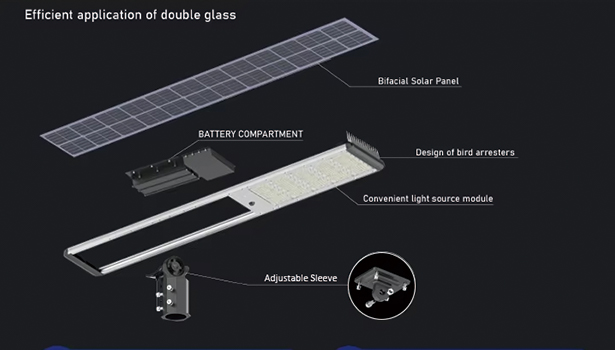
LED light source
- Dismantle the “more the better”misconception
Many people think that the more LED beads, the brighter the street light. But in fact, solar lamps and lanterns by the battery power supply, its power depends entirely on the battery capacity. For example, when the battery can only support 20 watts for 10 hours, the actual power of the street light can only reach 20 watts at most, regardless of whether 50 or 500 light beads are installed. Physically, the longer the distance electricity travels through a circuit, the more resistance it creates. More beads will result in longer circuits and higher resistance, thus wasting more power.
- Choosing the right LED configuration
Therefore, when choosing LED light source, not the more beads the better, but according to the battery capacity and the actual lighting requirements, choose a sufficient number of LED configuration that can meet the brightness requirements, in order to avoid unnecessary waste of power, to ensure that the street light in the limited power to play the best lighting effect.
Strert Light body shell
The importance of material quality
Solar lamps and lanterns shell material is mainly divided into plastic type and cast aluminum type two.
- Plastic shell: plastic shell cost is lower, but in the outdoor environment, after sun exposure, its life is shorter, waterproof performance is also poor. Long-term use may appear shell aging, rupture and other problems, affecting the normal use of street lights and safety.
- Die-casting aluminum shell: die-casting aluminum shell has the advantages of durability, waterproof and good heat dissipation. In outdoor projects, usually choose thick die-casting aluminum shell to ensure that the street light can adapt to a variety of harsh environments. However, the disadvantage of die-casting aluminum shell is relatively high cost.
The impact of shell material on the performance of street lights
Different shell materials have a significant impact on the performance and service life of street lights. High-quality die-casting aluminum shell can effectively protect the internal components and extend the service life of the street light, while good waterproof and heat dissipation also help to improve the stability and lighting effect of the street light. While the plastic shell, although low-cost, but the lack of performance may lead to frequent failures of street lights, increasing maintenance costs.
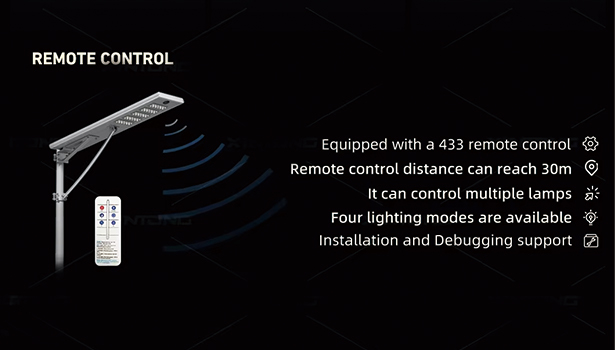
Control system
- Functions of control system
Most of the solar lamps and lanterns have remote control, light control, time control, full brightness, half-bright, fully automatic and other functions, and the realization of these functions can not be separated from the control system.
- The role of battery protection and lighting control
Due to the limitations of the battery capacity, solar lamps and lanterns can not be like the utility lamps and lanterns as always with 100% of the power to light. In continuous cloudy and rainy days, the battery capacity is reduced, and the street lamps can not work normally like full power.
At this time, the intelligent control system is particularly important. It can intelligently adjust the power output according to the real-time capacity of the batteries to ensure that the streetlights operate under good working conditions, thus extending the service life of the streetlights.
For example, the control system we use can not only realize the above basic functions, but also accurately control the input and output of the battery to avoid overcharging and overdischarging of the battery, effectively protect the battery life, so that the street light is more durable.
Other important qualities of high-quality LED solar street lights
Intelligent LED lighting to achieve energy saving
- Huge energy-saving potential
With the development of science and technology, intelligent LED lighting is more and more widely used in solar street lights. Compared with traditional lighting systems, solar street lights with intelligent LED lighting can achieve 50% - 70% energy savings. This is mainly due to the high efficiency and energy saving characteristics of LED lamps and the precise management of energy by intelligent control system.
- Integration with smart city concept
Intelligent LED solar street lights can also be integrated with other concepts of smart cities. For example, some smart street lights integrate motion sensors, Wi-Fi, weather sensors, CO2 sensors and other smart sensors. These sensors not only enable intelligent control of street lights, automatically adjusting lighting brightness according to environmental changes, but also provide rich data for city management, such as traffic flow monitoring, environmental air quality monitoring, etc., to further enhance the city's level of intelligence.
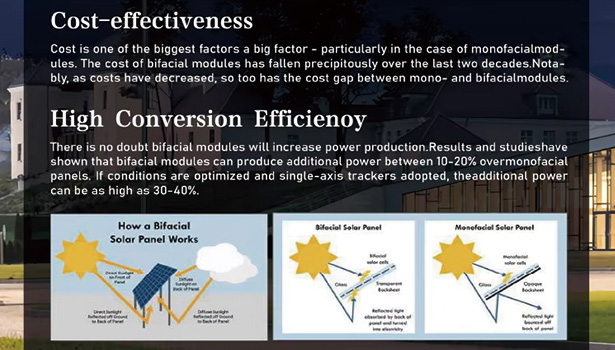
Provide appropriate lighting
- Comply with CIE standards
The International Commission on Illumination (CIE) stipulates that the illumination level at 5 meters in front of the road should reach 50%. Proper lighting level is essential for road traffic safety. Only with sufficient illumination can drivers see objects around the road clearly and avoid traffic accidents caused by poor visibility.
- Avoid inappropriate lighting levels
Inappropriate lighting levels, whether too bright or too dim, can have a negative impact on a driver's vision. Excessively bright lighting may lead to glare, which may cause eye fatigue to drivers and affect driving safety; while excessively dim lighting may reduce drivers' visibility of the road environment and increase driving risks. Therefore, ensuring that streetlights provide the proper level of illumination is one of the important qualities of quality solar streetlights.
Long life and high durability
- Reduce maintenance costs
High-quality LED solar streetlights should have a long lifespan. LED streetlights usually have a lifespan of 50,000 - 100,000 hours, which means that the frequency of replacement and maintenance is greatly reduced compared to other traditional lighting fixtures. This not only saves manpower, material and financial resources, but also reduces the impact of street light maintenance on traffic and residents' lives.
- Adapt to the harsh outdoor environment
Street lights are exposed to the outdoor environment for a long time, and need to have high durability to withstand all kinds of harsh weather conditions, such as sun exposure, wind and rain attacks, high and low temperature changes. From the photovoltaic panel to the light body shell, each component should be made of high-quality materials to ensure that the street light can operate stably in different environments and extend its overall service life.
Glare-free lighting
- Problems caused by glare
Glare will cause driver's eye fatigue and distraction, posing a serious threat to road traffic safety. When the brightness of the light exceeds the adaptation level of the human eye, the phenomenon of glare will occur, which will not only affect the driver's judgment of the road situation, but also may lead to pedestrians crossing the road due to the obstruction of the driver's line of sight and danger.
2.LED street light solves the problem of glare
LED street light can effectively reduce the generation of glare through reasonable optical design and optimization of lamp structure. For example, the use of special lampshade design or light-emitting angle control technology, so that the light is more evenly distributed on the road, to avoid direct light to the driver's eyes, so as to provide a safe and comfortable lighting environment.
Comparison of Different Types of Street Lights and Advantages of LED Street Lights
Comparison of the characteristics of various types of streetlights
|
Technology |
Application Area |
Advantages |
Disadvantages |
Cost |
Lifespan |
Environmental Impact |
|
Fluorescent Lamp |
General Lighting |
High Efficiency |
Contains Mercury |
Low |
Long |
Moderate |
|
LED Lamp |
Decorative Lighting, Display |
Energy Saving |
High Initial Cost |
High |
Very Long |
Low |
|
High Pressure Sodium Lamp (HPS) |
Street Lighting |
Good Color Rendering |
Slow Start |
Medium |
Long |
Moderate |
|
Metal Halide Lamp |
Commercial Lighting |
High Brightness |
High Maintenance Cost |
High |
Medium |
High |
|
Incandescent Lamp |
Residential Lighting |
Warm Light |
Low Efficiency |
Low |
Short |
High |
High Pressure Sodium Lamp (HPS): High Pressure Sodium Lamps emit a typical yellow - orange light, although with high efficiency and long life, but there are some limitations in color rendering and visibility, and the color of its light may affect the judgment of the true color of the object.
Metal halide lamps: metal halide lamps are brighter than high-pressure sodium lamps and whiter, better color rendering, but not as good as LED street lamps in terms of efficiency and life expectancy, the need for more frequent replacement of light bulbs, increasing maintenance costs.
Induction lamps: induction lamps have good visibility and color rendering, but due to its technical characteristics, installation and maintenance costs are relatively high, which to some extent limits its wide application.
The advantages of LED street lights
- High energy efficiency: LED street lights compared to traditional lighting systems, energy consumption can be reduced by 50% - 70%. This means that in the case of meeting the same lighting requirements, LED street lights can consume less electricity, thus saving users a lot of electricity expenses, but also reduces carbon emissions, in line with the concept of environmental protection.
- Long life: The long life of LED street light makes its replacement frequency greatly reduced. Its life expectancy can reach 50,000 - 100,000 hours, compared with other lamps and lanterns, significantly reduces the workload of maintenance and replacement, reducing maintenance costs.
- Excellent light quality: LED street lights have high color rendering index, which can more realistically restore the color of objects and improve the visibility of the road. At the same time, its light distribution is more uniform, reducing shadows and glare, providing a more comfortable and safe lighting environment for drivers and pedestrians.
- Environmentally friendly: LED streetlights are recyclable and do not contain harmful chemicals, such as mercury, which are more common in traditional lighting technologies. The use of LED street lights helps to reduce environmental pollution, in line with the requirements of sustainable development.
- Intelligent technology compatibility: Modern LED streetlights can be perfectly integrated with smart city technology. By connecting with the intelligent control system, the brightness of street lights can be remotely monitored and adjusted according to factors such as traffic flow, weather conditions and time to achieve more intelligent and humanized lighting management.
Important considerations when selecting streetlights
Lighting assessment indicators
- Average road brightness (Lav): Average road brightness is an important indicator of road visibility. It depends on the light distribution of the lamps, the lumen output, the installation design of the street lamps and the reflective properties of the road surface. The higher the luminance level, the better the lighting effect. According to the lighting class standard, the Lav ranges from 0.3 - 2.0 Cd/m².
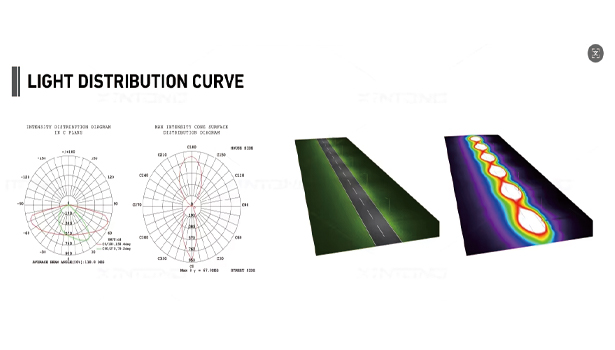
- Uniformity (overall and longitudinal)
- Overall uniformity (U0): The overall uniformity is defined as the ratio of the minimum brightness to the average brightness on the road. Good overall uniformity ensures that all points and objects on the road are adequately illuminated so that drivers can see the road clearly. The accepted U0 value for the road lighting industry is 0.40.
- Longitudinal uniformity (U1): Longitudinal uniformity is the difference in brightness between the brightest and darkest areas along the centerline of the lane. Good longitudinal uniformity reduces the pattern of high and low brightness on the road (i.e., the “zebra effect”) and provides drivers with more comfortable driving conditions, especially for long and continuous roads.
- Glare (Threshold Increment - TI): Glare refers to the harsh sensation that occurs when the brightness of light exceeds the level to which the human eye adapts to light. It causes discomfort and reduces roadway visibility. Glare is measured by the Threshold Increment (TI), which is the percentage increase in brightness needed to compensate for the effects of glare (even if the roadway would be visible without the glare). Glare standards in the street lighting industry range from 10% - 20%.
- Average roadway illuminance, minimum roadway illuminance, and vertical illuminance: the average of illuminance measured or calculated at pre-determined points on the roadway according to CIE regulations. Lighting requirements for motorways are usually based on luminance, while lighting requirements for sidewalks are mainly based on roadway illuminance. Illuminance depends on the light distribution of the luminaire, the lumen output, and the installation design of the streetlight, but has less to do with the reflective properties of the roadway. In sidewalk lighting, attention also needs to be paid to illuminance uniformity UE (Lmin/Lav), which is the ratio of the minimum illuminance to the average illuminance on the roadway. In order to ensure uniformity, the actual maintenance of the average illuminance value should not exceed the specified level value of 1.5 times.
- Surrounding ratio (SR): Surrounding ratio refers to the road outside the 5-meter-wide area of the average level of illumination and the adjacent road 5-meter-wide area of the average level of illumination ratio. Roadway lighting should illuminate not only the roadway itself, but also the adjacent area so that drivers can see surrounding objects and anticipate possible roadway obstacles (e.g., pedestrians about to walk on the roadway.) SR reflects the visibility of the roadway's perimeter relative to the main roadway itself. According to lighting industry standards, SR should be at least 0.50, which is a desirable and sufficient value to ensure eye adaptation.
- Color Rendering Index (CRI): CRI is a measure of the ability of an artificial light source to show or reproduce the color of a roadway or object on a roadway relative to a natural light source. A natural light source (the sun) has a CRI of 100; the higher the index, the better the visibility. For all types of roadway lighting levels, a CRI ≥ 70 is recommended.
- Visual induction: Through the road's guidance aids, such as road centerlines, curbstones, road signs, emergency road guardrails, etc., drivers are able to clarify their position and the direction ahead of the road. These facilities can help drivers better judge the driving direction and improve driving safety under night lighting conditions.
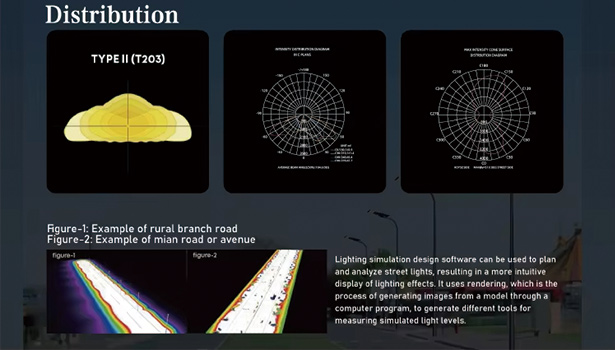
To summarize, high-quality LED solar street lights should have a variety of excellent qualities. From the point of view of the key components, photovoltaic panels need to have a high photoelectric conversion efficiency and sufficient power output, the battery should be able to protect the service life of the street lamp, LED light source should be reasonably configured according to the capacity of the battery, the lamp body shell should be durable and waterproof heat dissipation, the control system should be intelligent and can effectively protect the battery.
In terms of other qualities, it should realize intelligent energy saving, provide proper lighting, have long life and high durability, and achieve glare-free lighting. Compared with other types of streetlights, LED streetlights have significant advantages in terms of energy efficiency, longevity, light quality, environmental protection and smart compatibility.
When selecting street lights, it is also necessary to comprehensively consider the lighting assessment indicators. Only by fully considering these factors can we choose or install the right LED solar street lights to meet the lighting needs of different scenarios and provide safe, efficient and environmentally friendly lighting for nighttime travel in cities and villages.

